Operation Weserübung
| Operation Weserübung | |||||||
|---|---|---|---|---|---|---|---|
| Part of the Norwegian Campaign of the Second World War | |||||||
 Clockwise from top: German forces advancing near Bagn in Valdres, King Haakon VII of Norway and his son Crown Prince Olav during a German air raid on Molde, German bombing of the coastal fortress Oscarsborg, German Gebirgsjäger troops near Narvik, and Norwegian artillery in action near Narvik. | |||||||
| |||||||
| Belligerents | |||||||
| Commanders and leaders | |||||||
| Strength | |||||||
|
| ||||||
| Casualties and losses | |||||||
|
| ||||||
Operation Weserübung (German: [ˈveːsɐˌʔyːbʊŋ]) was the code name for Germany's assault on Denmark and Norway during the Second World War and the opening operation of the Norwegian Campaign. The name comes from the German for Operation Weser-Exercise (Unternehmen Weserübung), the Weser being a German river.
In the early morning of 9 April 1940 (Wesertag; "Weser Day"), Germany invaded Denmark and Norway, ostensibly as a preventive manoeuvre against a planned, and openly discussed, Franco-British occupation of Norway. After the invasions, envoys of the Germans informed the governments of Denmark and Norway that the Wehrmacht had come to protect the countries' neutrality against Franco-British aggression. Significant differences in geography, location and climate between the two countries made the actual military operations very dissimilar.
The invasion fleet's nominal landing time—Weserzeit ("Weser Time")—was set to 05:15 German time, equivalent to 04:15 Norwegian time.
Political and military background
Starting in the spring of 1939, the British Admiralty began to view Scandinavia as a potential theatre of war in a future conflict with Germany. The British government was reluctant to engage in another land conflict on the continent that they believed would be a repetition of the First World War. So they began considering a blockade strategy in an attempt to weaken Germany indirectly. German industry was heavily dependent on the import of iron ore from the northern Swedish mining district, and much of this ore was shipped through the northern Norwegian port of Narvik during the winter months.[3] Control of the Norwegian coast would also serve to tighten a blockade against Germany.
In October 1939, the chief of the German Kriegsmarine—Grand Admiral Erich Raeder—discussed with Adolf Hitler the danger posed by the risk of having potential British bases in Norway and the possibility of Germany seizing these bases before the United Kingdom could. The navy argued that possession of Norway would allow control of the nearby seas and serve as a staging base for future submarine operations against the United Kingdom.[3] But at this time, the other branches of the Wehrmacht were not interested, and Hitler had just issued a directive stating that the main effort would be a land offensive through the Low Countries.
Toward the end of November, Winston Churchill—as a new member of the British War Cabinet—proposed the mining of Norwegian waters in Operation Wilfred. This would force the ore transports to travel through the open waters of the North Sea, where the Royal Navy could intercept them. Churchill assumed that Wilfred would provoke a German response in Norway. When that occurred, the Allies would implement Plan R 4 and occupy Norway. Though later implemented, Operation Wilfred was initially rejected by Neville Chamberlain and Lord Halifax, due to fear of an adverse reaction among neutral nations such as the United States. After the start of the Winter War between the Soviet Union and Finland in November had changed the diplomatic situation, Churchill again proposed his mining scheme, but once more was denied.
In December, the United Kingdom and France began serious planning for sending aid to Finland. Their plan called for a force to land at Narvik in northern Norway, the main port for Swedish iron ore exports, and to take control of the Malmbanan railway line from Narvik to Luleå in Sweden on the shore of the Gulf of Bothnia. Conveniently, this plan also would allow the Allied forces to occupy the Swedish iron ore mining district. The plan received the support of both Chamberlain and Halifax. They were counting on the cooperation of Norway, which would alleviate some of the legal issues, but stern warnings issued to both Norway and Sweden resulted in strongly negative reactions in both countries. Planning for the expedition continued, but the justification for it was removed when Finland sued for peace in March 1940.
Planning
Following a meeting with Vidkun Quisling from Norway on 14 December,[4] Hitler turned his attention to Scandinavia. Convinced of the threat posed by the Allies to the iron ore supply, Hitler ordered Oberkommando der Wehrmacht (Armed Forces High Command; OKW) to begin preliminary planning for an invasion of Norway. The preliminary plan was named Studie Nord and only called for one army division.
Between 14 and 19 January, the Kriegsmarine developed an expanded version of this plan. They decided upon two key factors: that surprise was essential to reduce the threat of Norwegian resistance (and British intervention); the second to use faster German warships, rather than comparatively slow merchant ships, as troop transports. This would allow all targets to be occupied simultaneously, as transport ships only had limited speed. This new plan called for a full army corps, including a mountain division, an airborne division, a motorized rifle brigade, and two infantry divisions. The target objectives of this force were the Norwegian capital Oslo and nearby population centres, Bergen, Narvik, Tromsø, Trondheim, Kristiansand, and Stavanger. The plan also called for the rapid capture of the kings of Denmark and Norway in the hopes that would trigger a rapid surrender.
On 21 February 1940, command of the operation was given to General Nikolaus von Falkenhorst. He had fought in Finland during the First World War and was familiar with Arctic warfare. But he was only to have command of the ground forces, despite Hitler's desire to have a unified command.
The final plan was code-named Operation Weserübung ("Exercise on the Weser") on 27 January 1940. The ground forces would be the XXI Army, including the 3rd Mountain Division and five infantry divisions, none of the latter having yet been tested in battle. The initial echelon would consist of three divisions for the assault, with the remainder to follow in the next wave. Three companies of paratroopers would be used to seize airfields. The decision to also send the 2nd Mountain Division was made later.
Almost all U-boat operations in the Atlantic were to be stopped in order for the submarines to aid in the operation. Every available submarine—including some training boats—were used as part of Operation Hartmut in support of Weserübung.
Initially, the plan was to invade Norway and to gain control of Danish airfields by diplomatic means. But Hitler issued a new directive on 1 March that called for the invasion of both Norway and Denmark. This came at the insistence of the Luftwaffe to capture fighter bases and sites for air-warning stations. The XXXI Corps was formed for the invasion of Denmark, consisting of two infantry divisions and the 11th motorized brigade. The entire operation would be supported by the X Air Corps, consisting of some 1,000 aircraft of various types.
Preliminaries

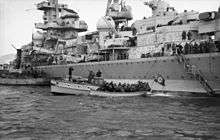
In February, the British destroyer HMS Cossack boarded the German transport ship Altmark while in Norwegian waters, thereby violating Norwegian neutrality, rescuing POWs held also in violation of Norwegian neutrality (the Altmark was obliged to release them as soon as she entered neutral territory). Hitler regarded this as a clear sign that the UK was willing to violate Norwegian neutrality, and so became even more strongly committed to the invasion.[3]
On 12 March, the United Kingdom decided to send an expeditionary force to Norway just as the Winter War was winding down. The expeditionary force began boarding on 13 March, but it was recalled—and the operation cancelled—with the end of the Winter War. Instead, the British cabinet voted to proceed with the mining operation in Norwegian waters, followed by troop landings.
The first German ships set sail for the invasion on 3 April. Two days later, the long-planned Operation Wilfred was put into action, and the Royal Navy detachment—led by the battlecruiser HMS Renown—left Scapa Flow in order to mine Norwegian waters. The mine fields were laid in the Vestfjorden in the early morning of 8 April. Operation Wilfred was over, but later that day, the destroyer HMS Glowworm—detached on 7 April to search for a man lost overboard—was lost in action to the German heavy cruiser Admiral Hipper and two destroyers belonging to the German invasion fleet.
On 9 April, the German invasion was under way and the execution of Plan R 4 was promptly started.
Invasion of Denmark
.jpg)
Strategically, Denmark's importance to Germany was as a staging area for operations in Norway, and of course as a border nation to Germany which would have to be controlled in some way. Given Denmark's position in relation to the Baltic Sea the country was also important for the control of naval and shipping access to major German and Soviet harbours.
At 04:00 on 9 April 1940, the German ambassador to Denmark—Cecil von Renthe-Fink—called the Danish Foreign Minister Peter Munch and requested a meeting with him. When the two men met 20 minutes later, Renthe-Fink declared that German troops were at that moment moving in to occupy Denmark to protect the country from Franco-British attack. The German ambassador demanded that Danish resistance cease immediately and contact be made between Danish authorities and the German armed forces. If the demands were not met, the Luftwaffe would bomb the capital, Copenhagen.
As the German demands were communicated, the first German advances had already been made, with forces landing by ferry in Gedser at 03:55 and moving north. German Fallschirmjäger units had made unopposed landings and taken two airfields at Aalborg, the Storstrøm Bridge as well as the fortress of Masnedø, the latter being the first recorded attack in the world made by paratroopers.[5]
At 04:20 local time, a reinforced battalion of German infantrymen from the 308th Regiment landed in Copenhagen harbour from the minelayer Hansestadt Danzig, quickly capturing the Danish garrison at the Citadel without encountering resistance. From the harbour, the Germans moved toward Amalienborg Palace to capture the Danish royal family. By the time the invasion forces arrived at the king's residence, the King's Royal Guard had been alerted and other reinforcements were on their way to the palace. The first German attack on Amalienborg was repulsed, giving Christian X and his ministers time to confer with the Danish Army chief General Prior. As the discussions were ongoing, several formations of Heinkel He 111 and Dornier Do 17 bombers roared over the city dropping OPROP! leaflets.
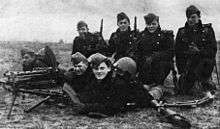
At 05:25, two squadrons of German Bf 110s attacked Værløse airfield on Zealand and neutralised the Danish Army Air Service by strafing.[6] Despite Danish anti-aircraft fire, the German fighters destroyed ten Danish aircraft and seriously damaged another fourteen, thereby wiping out half of the entire Army Air Service.[6]
Faced with the explicit threat of the Luftwaffe bombing the civilian population of Copenhagen, and only General Prior in favour of continuing to fight, the King Christian X and the entire Danish government capitulated at approximately 06:00 in exchange for retaining political independence in domestic matters.
The invasion of Denmark lasted less than six hours and was the shortest military campaign conducted by the Germans during the war. The rapid Danish capitulation resulted in the uniquely lenient occupation of Denmark, particularly until the summer of 1943, and in postponing the arrest and deportation of Danish Jews until nearly all of them were warned and on their way to refuge in Sweden.[7] In the end, 477 Danish Jews were deported, and 70 of them lost their lives, out of a pre-war total of Jews and half-Jews at a little over 8,000.[8]
Invasion of Norway
Order of battle
Norway was important to Germany for two primary reasons: as a base for naval units, including U-boats, to harass Allied shipping in the North Atlantic, and to secure shipments of iron-ore from Sweden through the port of Narvik.[3] The long northern coastline was an excellent place to launch U-boat operations into the North Atlantic in order to attack British commerce. Germany was dependent on iron ore from Sweden and was worried, with justification, that the Allies would attempt to disrupt those shipments, 90% of which originated from Narvik.
The invasion of Norway was given to the XXI Army Corps under General Nikolaus von Falkenhorst and consisted of the following main units:
- 69th Infantry Division
- 163rd Infantry Division
- 181st Infantry Division
- 196th Infantry Division
- 214th Infantry Division
- 3rd Mountain Division
The initial invasion force was transported in several groups by ships of the Kriegsmarine:
- Battleships Scharnhorst and Gneisenau as distant cover, plus 10 destroyers with 2,000 mountaineering troops under General Eduard Dietl to Narvik;
- Heavy cruiser Admiral Hipper and four destroyers with 1,700 troops to Trondheim;
- Light cruisers Köln and Königsberg, artillery training ship Bremse, Schnellboot mothership Karl Peters, two torpedo boats and five motor torpedo boats with 1,900 troops to Bergen;
- Light cruiser Karlsruhe, three torpedo boats, seven motor torpedo boats and Schnellboot mothership (Schnellbootbegleitschiff) Tsingtau with 1,100 troops to Kristiansand and Arendal;
- Heavy cruiser Blücher, heavy cruiser (formerly pocket battleship) Lützow, light cruiser Emden, three torpedo boats and eight minesweepers with 2,000 troops to Oslo;
- Four minesweepers with 150 troops to Egersund.
Concise timeline
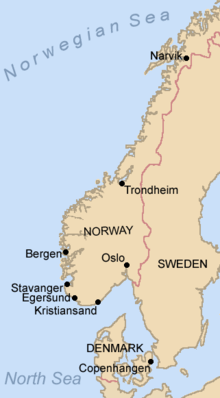
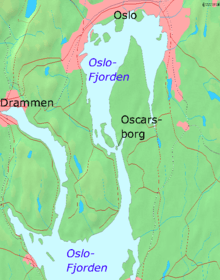
- Shortly after noon on 8 April, the clandestine German troop transport Rio de Janeiro was sunk off Lillesand by the Polish submarine Orzeł, part of the Royal Navy's 2nd Submarine Flotilla. However, the news of the sinking reached the appropriate levels of officialdom in Oslo too late to do much more than trigger a limited, last-minute alert.
- Late in the evening of 8 April 1940, Kampfgruppe 5 was spotted by the Norwegian guard vessel Pol III. Pol III was fired at, her captain Leif Welding-Olsen became the first Norwegian killed in action during the war.
- German ships sailed up the fjord leading to Oslo, reaching the Drøbak Narrows (Drøbaksundet). In the early morning of 9 April, the gunners at Oscarsborg Fortress fired on the leading ship, Blücher, which had been illuminated by spotlights at about 04:15. Two of the guns used were the 48-year-old German Krupp guns (named Moses and Aron) of 280 mm (11 in) calibre. Within two hours, the badly damaged ship, unable to manoeuvre in the narrow fjord from multiple artillery and torpedo hits, sank with very heavy loss of life totalling 600–1,000 men. The now obvious threat from the fortress (and the mistaken belief that mines had contributed to the sinking) delayed the rest of the naval invasion group long enough for the Royal family, the Cabinet Nygaardsvold and the Parliament to be evacuated, along with the national treasury. On their flight northward by special train, the court encountered the Battle of Midtskogen and bombs at Elverum and Nybergsund. As the legitimate government and royal family were not captured, Norway never surrendered to the Germans, leaving the Quisling government illegitimate and having Norway participating as an Ally in the war, rather than as a conquered nation.
- German airborne troops landed at Oslo airport Fornebu, Kristiansand airport Kjevik, and Sola Air Station – the latter constituting the first opposed paratrooper (Fallschirmjäger) attack in history;[3] coincidentally, among the Luftwaffe pilots landing at Kjevik was Reinhard Heydrich.
- Vidkun Quisling's radio-effected coup d'etat at 7.30pm on 9 April[9] – another first.
- Cities/towns Bergen, Stavanger, Egersund, Kristiansand S, Arendal, Horten, Trondheim and Narvik attacked and occupied within 24 hours.
- Heroic, but wholly ineffective, stand by the Norwegian armoured coastal defence ships Norge and Eidsvold at Narvik. Both ships torpedoed and sunk with great loss of life.
- First Battle of Narvik (Royal Navy vs Kriegsmarine) on 9 April.[10]
- The German force took Narvik and landed the 2,000 mountain infantry, but a British naval counter-attack by the modernised battleship HMS Warspite and a flotilla of destroyers over several days succeeded in sinking all ten German destroyers once they ran out of fuel and ammunition.
- Devastating bombing of towns Nybergsund, Elverum, Åndalsnes, Molde, Kristiansund N, Steinkjer, Namsos, Bodø, Narvik – some of them tactically bombed, some terror-bombed.
- Main German land campaign northward from Oslo with superior equipment; Norwegian soldiers with turn-of-the-century weapons, along with some British and French troops (see Namsos Campaign), stop invaders for a time before yielding – first land combat action between British Army and Wehrmacht in World War II.
- Second Naval Battle of Narvik (Royal Navy vs Kriegsmarine) on 13 April.[11]
- Land battles at Narvik: Norwegian and Allied (French and Polish) forces under General Carl Gustav Fleischer achieve the first major tactical victory against the Wehrmacht in WWII, and the following withdrawal of the Allied forces (mentioned below); Fighting at Gratangen.
- With the evacuation of the King and the Cabinet Nygaardsvold from Molde to Tromsø on 29 April, and the allied evacuation of Åndalsnes on 1 May, resistance in Southern Norway comes to an end.
- The "last stand": Hegra Fortress (Ingstadkleiven Fort) resisted German attacks until 5 May – of Allied propaganda importance, like Narvik.
- King Haakon, Crown Prince Olav, and the Cabinet Nygaardsvold left from Tromsø 7 June (aboard the British cruiser HMS Devonshire, bound for Britain) to represent Norway in exile (King returned to Oslo exact same date five years later); Crown Princess Märtha and children, denied asylum in her native Sweden, later left from Petsamo, Finland, to live in exile in the United States.
- The Norwegian Army capitulated (though Norwegian armed forces continued fighting the Germans abroad and at home until the German capitulation on 8 May 1945) on 10 June 1940, two months after Wesertag, this made Norway the occupied country which had withstood a German invasion for the longest time before succumbing.
In the far north, Norwegian, French and Polish troops—supported by the Royal Navy and the Royal Air Force (RAF)—fought against the Germans over the control of the Norwegian harbour Narvik, important for the year-round export of Swedish iron ore (The Swedish harbour of Luleå is blocked by ice in the winter months). The Germans were driven out of Narvik on 28 May, but due to the deteriorating situation on the European continent, the Allied troops were withdrawn in Operation Alphabet – and the Germans recaptured Narvik on 9 June, by then deserted also by the civilians due to massive Luftwaffe bombing.
Encircling of Sweden and Finland
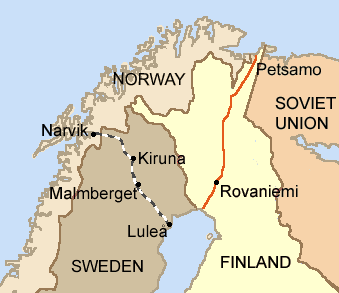
Operation Weserübung did not include a military assault on (likewise neutral) Sweden because there was no need. By holding Norway, the Danish straits and most of the shores of the Baltic Sea, the Third Reich encircled Sweden from the north, west and south – and in the East, there was the Soviet Union, the successor of Sweden's and Finland's arch-enemy Russia, on friendly terms with Hitler under the terms of the Molotov–Ribbentrop Pact. A small number of Finnish volunteers helped the Norwegian Army against Germans in an ambulance unit.
Sweden's and Finland's trade was totally controlled by the Kriegsmarine. As a consequence, Germany put pressure on neutral Sweden to permit transit of military goods and soldiers on leave. On 18 June 1940, an agreement was reached. Soldiers were to travel unarmed and not be part of unit movements. A total of 2.14 million German soldiers, and more than 100,000 German military railway carriages, crossed Sweden until this traffic was officially suspended on 20 August 1943.
On 19 August 1940, Finland agreed to grant access to its territory for the Wehrmacht, with the agreement signed on 22 September. Initially for transit of troops and military equipment to and from northernmost Norway, but soon also for minor bases along the transit road that eventually would grow in the preparation for Operation Barbarossa.
Nuremberg Trials
The 1941 Anglo-Soviet invasion of Iran, and the 1940 German invasion of Norway have been argued to be preemptive, with the German defense in the Nuremberg trials in 1946 arguing that Germany was "compelled to attack Norway by the need to forestall an Allied invasion and that her action was therefore preemptive."[12] The German defence was to attempt to refer to Plan R 4 and its predecessors. However it was determined that Germany had discussed invasion plans as early as 3 October 1939 when in a memo from Admiral Raeder to Alfred Rosenberg whose subject was "gaining bases in Norway."[13] had begun by asking questions such as "Can bases be gained by military force against Norway's will, if it is impossible to carry this out without fighting?"[13] Norway was vital to Germany as a transport route for iron ore from Sweden, a supply that the United Kingdom was determined to stop. One British plan was to go through Norway and occupy cities in Sweden.[a][b] An Allied invasion was ordered on 12 March, and the Germans intercepted radio traffic setting 14 March as deadline for the preparation. Peace in Finland interrupted the Allied plans.[c] Two diary entries by Jodl dated 13 and 14 March did not indicate any high level awareness of the Allied plan although they do show that Hitler was actively considering putting Operation Weserübung into operation: The first said "Fuehrer does not give order yet for 'Weser Exercise'. He is still looking for an excuse."[13] and the second "Fuehrer has not yet decided what reason to give for Weser Exercise."[13] It was not till 2 April 1940 that German preparations were completed and the Naval Operational Order for Weserübung was issued on 4 April 1940. The new Allied plans were Wilfred and Plan R 4. The plan was to provoke a German reaction by laying mines in Norwegian waters, and once Germany showed signs of taking action UK troops would occupy Narvik, Trondheim, and Bergen and launch a raid on Stavanger to destroy Sola airfield. However "the mines were not laid until the morning of 8 April, by which time the German ships were advancing up the Norwegian coast."[14] The International Military Tribunal at Nuremberg determined that no Allied invasion was imminent, and therefore rejected the German argument that Germany was entitled to attack Norway.[13]
See also
- Allied campaign in Norway
- Alta Battalion
- Battle of Drøbak Sound
- Battle of Kristiansand
- Battles of Narvik
- British occupation of the Faroe Islands in World War II
- Kampf um Norwegen – Feldzug 1940 (1940 documentary film)
- Luftwaffe Order of Battle April 1940
- List of shipwrecks in April 1940
- Norwegian resistance movement
- Occupation of Denmark
- Occupation of Norway by Nazi Germany
- Operation Juno
- Operation Weserübung's effects on Sweden
- Timeline of the Norwegian Campaign
Notes
- a "The British plan which was adopted was more modest. While ostensibly intended to bring Allied troops to the Finnish front, it laid its main emphasis on operations in northern Norway and Sweden. The main striking force was to land at Narvik and advance along the railroad to its eastern terminus at Lulea, occupying Kiruna and Gallivare along the way. By late April two Allied brigades were to be established along that line."[15]
- b "The British held back two divisions from France, intending to put them into the field in Norway, and planned to expand their force eventually to 100,000 men. The French intended to commit about 50,000. The British and French staffs agreed that the latter half of March would be the best time for going into Norway."[16]
- c "The objectives were to take Narvik, the railroad, and the Swedish ore fields","an intercepted radio message setting 14 March as the deadline for preparation of transport groups indicated that the Allied operation was getting under way. But another message, intercepted on the 15th, ordering the submarines to disperse revealed that the peace [in Finland] had disrupted the Allied plan."[17]
References
- ↑ Hooton 2007, p. 43.
- ↑ Zabecki 2014, p. 323.
- 1 2 3 4 5 Booth 1998, pp. 44-49.
- ↑ Petrow 1974, p. 15.
- ↑ Outze 1962, p. 359.
- 1 2 Schrøder 1999.
- ↑ Danish Jewish Museum 2003.
- ↑ Webb 2007.
- ↑ Petrow 1974, p. 72.
- ↑ Petrow 1974, p. 89.
- ↑ Petrow 1974, p. 90.
- ↑ McDouglas 1997, pp. 211-212.
- 1 2 3 4 5 Yale Law School 2008.
- ↑ Ziemke 1960, p. 68.
- ↑ Ziemke 1960, p. 59.
- ↑ Ziemke 1960, pp. 66-67.
- ↑ Ziemke 1959, pp. 67-68.
Bibliography
- Booth, Owen (1998). The Illustrated History of World War II. London: Chartwell Books, Inc. ISBN 978-078581-016-2.
- Hooton, Edward R. (2007). Luftwaffe at War; Blitzkrieg in the West: Volume 2. London: Chervron/Ian Allan. ISBN 978-1-85780-272-6.
- McDouglas, Myres (1997). The International Law of War:Transnational Coercion and World Public Order. New York: Springer. ISBN 978-079232-584-0.
- Outze, Børge (1962). Danmark under anden verdenskrig (in Danish). Copenhagen: Hasselbalch. ISBN 87-567-1889-6.
- Petrow, Richard (1974). The Bitter Years; The Invasion and Occupation of Denmark and Norway, April 1940-May 1945. London: William Morrow & Co. ISBN 978-068800-275-6.
- Schrøder, Hans A. (1999). Angrebet på Værløse flyveplads den 9. april 1940 : flyveren Vagn Holms dagbog fra den 8. og 9. april suppleret med en omfattende dokumentation (in Danish). Denmark: Flyvevåbnets bibliotek. ISBN 87-982509-8-1.
- Zabecki, David T. (2014). Germany at War: 400 Years of Military History. London: ABC-Clio Inc. ISBN 978-1-59884-980-6.
- Ziemke, Earl F. (1960). "The German Decision to Invade Norway and Denmark". Command Decisions. United States Army Center of Military History. Retrieved 2016-08-18.
External links
- Derry, Trevor K. (1952). "The Campaign in Norway". ibiblio.org. Retrieved 2016-08-18.
- Engdahl, William F. (2010). "Halford MacKinder's Necessary War". ibiblio.org. Retrieved 2016-08-18.
- Danish Jewish Museum (2003). "The Operation against Danish Jews in October 1943". jewmus.dk. Retrieved 2016-08-19.
- Webb, Chris (2007). "The Fate of the Jews of Denmark". holocaustresearchproject.net. Retrieved 2016-08-19.
- Yale Law School (2008). "Judgement : The Invasion of Denmark and Norway". avalon.law.yale.edu. Retrieved 2016-08-19.
Coordinates: 64°00′N 12°00′W / 64.000°N 12.000°W